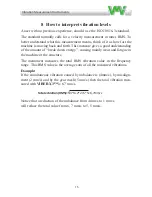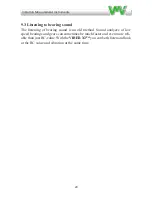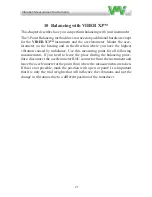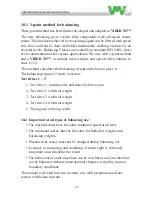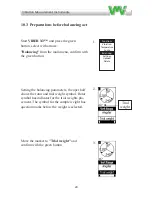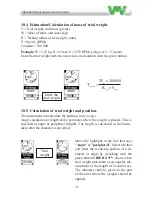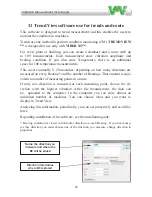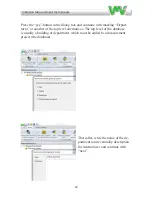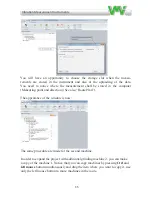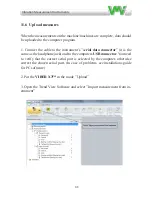
Vibraon Measurement Instruments
28
10.9 Balancing the machine
After driving 3 instrument automatically calculates the balance weight and
where it should be placed, by pushing the right arrow appears in the display
calculus (in our example. 4.1 grams) and a calculated improvement of 95.7%.
Checking the result
Scroll with the right arrow key to
Final unbalance
. Start the machne, check
that the speed is the same as the previous runs, wait for stable readings. Con-
firm with the green button. The end result in this example was better (98.4%)
than the estimated value. Balancing is now complete turn off the machine,
attach the weight permanently.
Save result
If balancing is to be saved, use the button ”Hold for SAVE key” select code
under which file should be saved. Confirm with the green button.
Test run No: 3
Move the test weight from (Item 2) to the calculated distance (in our example.
272.3 mm), calculated from (Item 1) to the direction of (Item 3) or 240 ° of
angle calculation used. Then do the same as when measured 1 and 2.
2.
Balancing the machine
After driving 3 instrument automatically calculates the balance weight and where it should
be placed, by pushing the right arrow appears in the display calculus (in our example. 4.1
grams) and a calculated improvement of 95.7%.
Remove the test weight from pos.3 or
240 ° and fit the calculated weight of
4.1 grams to the calculated distance
or angle indication in the instrument
(in this example. 283.0 mm) starting
from position 1 to the direction to the
position where the balancing weight
be installed, position 4.
Checking the result
Scroll with the right arrow key to Final imbalance. Start the machine, check that the speed is
the same as the previous runs, wait for stable readings. Confirm with the green button. The
end result in this example was better (98.4%) than the estimated value. Balancing is now
complete turn off the machine, attach the weight permanently.
Save result
If balancing is to be saved, use the button "SAVE" select code under which file should be
saved. Confirm with the green button.
Test run No: 3
Move the test weight from (Item 2) to the calculated dis
tance
(in our example. 272.3 mm), calculated from (Item 1) towards
the direction of (Item 3) or 240 ° of angle calculation used.
Then do the same as when measured 1 and 2.
Remove the test weight from pos.3 or 240 ° and fit the calculated weight of
4.1 grams to the calculated distance or angle indication in the instrument (in
this example. 283.0 mm) starting from position 1 towards the direction to the
position where the balancing weight be installed, position 4.
Test run No: 3
Move the test weight from (Item 2) to the calculated distance (in our example.
272.3 mm), calculated from (Item 1) to the direction of (Item 3) or 240 ° of
angle calculation used. Then do the same as when measured 1 and 2.
2.
Balancing the machine
After driving 3 instrument automatically calculates the balance weight and where it should
be placed, by pushing the right arrow appears in the display calculus (in our example. 4.1
grams) and a calculated improvement of 95.7%.
Remove the test weight from pos.3 or
240 ° and fit the calculated weight of
4.1 grams to the calculated distance
or angle indication in the instrument
(in this example. 283.0 mm) starting
from position 1 to the direction to the
position where the balancing weight
be installed, position 4.
Checking the result
Scroll with the right arrow key to Final imbalance. Start the machine, check that the speed is
the same as the previous runs, wait for stable readings. Confirm with the green button. The
end result in this example was better (98.4%) than the estimated value. Balancing is now
complete turn off the machine, attach the weight permanently.
Save result
If balancing is to be saved, use the button "SAVE" select code under which file should be
saved. Confirm with the green button.
6
3)
Test run No: 2
Moving the test weight from (position 1) to the calculated distance (in our example. 136.1 mm) to
the direction of rotation (Item 2), or if the angle calculation made to 120 °. Then do the same as the
sample measurement 1.
Test run No: 3
Move the test weight from (Item 2) to the calculated distance (in our example. 272.3 mm), calculated from (Item 1) to
the direction of (Item 3) or 240 ° of angle calculation used. Then do the same as when measured 1 and 2.
2.
Balancing the machine
After driving 3 instrument automatically calculates the balance weight and where it should be placed, by pushing the
right arrow appears in the display calculus (in our example. 4.1 grams) and a calculated improvement of 95.7%.
Remove the test weight from pos.3 or 240 ° and
fit the calculated weight of 4.1 grams to the
calculated distance or angle indication in the
instrument (in this example. 283.0 mm) starting
from position 1 to the direction to the position
where the balancing weight be installed, position
If the result is an error message, for
example:
”Irrational vibration level”
that
means that the trial weight is to small.
Summary of Contents for VIBER X3
Page 2: ......
Page 38: ...Vibra on Measurement Instruments 36...
Page 39: ...Vibra on Measurement Instruments 37...
Page 41: ...Vibra on Measurement Instruments 39...
Page 43: ...Vibra on Measurement Instruments 41...
Page 46: ...Vibra on Measurement Instruments 44 Click on next...
Page 48: ...Vibra on Measurement Instruments 46 Click on next...
Page 58: ...Vibra on Measurement Instruments 56...
Page 59: ......


